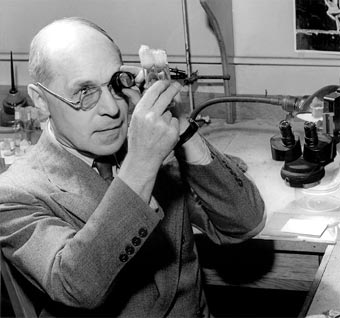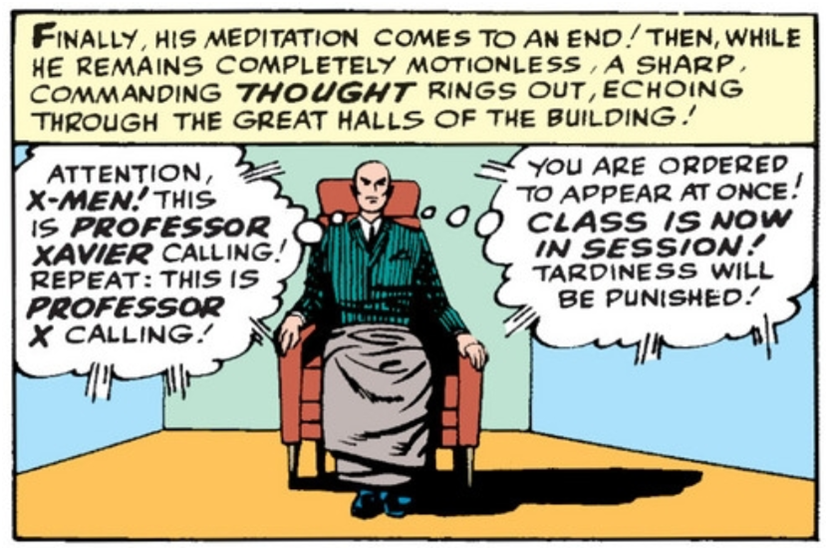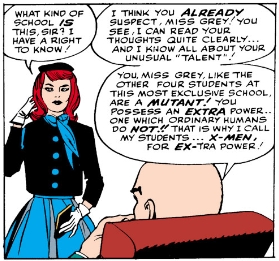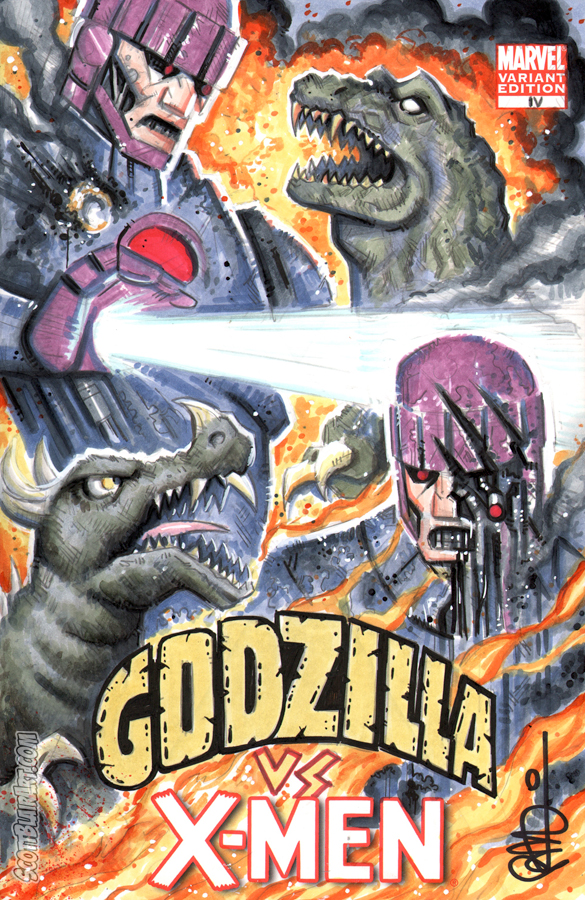
Fans of X-men: Days of Future Past excitedly point to the film’s overt “social commentary” as a major reason for its success. We always equate the X-men with these kinds of subjects – race, social injustice, politics – but why is that? Where does that stuff come from?
After the success of Spider-Man and the Fantastic Four, Stan Lee described his pre-X-men eureka moment as “What am I gonna do next?” Lee worked up a concept called “The Mutants” that he pitched to publisher Martin Goodman. It was soundly rejected. According to Lee, Goodman said: “Nobody is gonna know what a mutant is. You can’t call them the Mutants.”
So Lee changed it to “The X-men.” But in 1963’s X-men #1, he kept the word “mutant.” Why? Because Goodman was wrong. Lee, who read plenty of pulps and magazines, knew what the word meant. Most people did.

It was the Cold War and people were scared of radiation. A 1956 Times article titled “Atomic Mutants Unseen in Japan” tried to persuade readers that long-term fears were unfounded, though there might be “some other subtle change” in human physiology over time. Even when articles such as these were trying to assuage fears, their words inflamed them.
At the same time, Japan was watching the first Godzilla (1954) and Rodan (“Radon”) (1956) movies. Vague fears over “some subtle change” were enough to make pop culture monsters.

The most popular geneticist of the time was a University of Indiana professor named Dr. Hermann J. Muller. He won the 1946 Nobel Prize in “Physiology or Medicine” for discovering “that high energy radiations such as x-rays will produce mutations.” In his acceptance speech, entitled “The Production of Mutations,” Muller makes the claim that “there are sudden jumps, going all the way from one ‘elementary species’ to another” that he called mutation. Muller argues that mutation happens because of the application of “X-radiation.” He was quoted — and pictured — widely in newspapers and magazines.
In a March 1960 issue of Popular Science, an article titled “How to Breed Supermen” notes that “blunt-spoken Hermann J. Muller . . . wants to upgrade the tired old human race into a world-wide family of paragons – upright, loyal, tolerant, kindly, and very, very smart” Muller adds that “Physical improvement is needed, too [including] a ‘third eye’ [that] would display thoughts as pictures.”

Mutants, bald scientists, and telepathy? All included in a “wide family of paragons.”
Though some letter-writers labeled him a Nazi, Muller is insistent of his version of the future. Though he admits that mutation will take “billions of years,” he still debates the education of these mutant children as if it were beginning that coming fall:
The chief aims in the bringing up and education of children – more robust health; keener, deeper and more creative intelligence; genuine warmth of fellow feeling and cooperative disposition . . . All these faculties require the proper environment and education for their development, but it is the genetic endowment of an individual that forms the basis of their realization.

In fact, stories about “special educational facilities for the so-called ‘the gifted’” were also being hotly debated in the press. Schools like Hunter Elementary in New York that limited “its enrollment to children with I.Q.’s of at least 130, [were] revolutionizing its entire approach to the teaching of the intellectually gifted child.”

Could Muller and his radical ideas about radioactive mutants and their education have influenced Stan Lee in his creation of the X-men? Of homo superior? It turns out there are many more possible sources, but given the provocative, protective Muller, it is hard to miss the obvious parallels.  Talking about genetics was necessarily imaginative back then. Muller’s popularity shows that it was a topic that people were interested in. It is 2014 and two of the top movies of the summer are X-men and Godzilla. We still fear the future.
Talking about genetics was necessarily imaginative back then. Muller’s popularity shows that it was a topic that people were interested in. It is 2014 and two of the top movies of the summer are X-men and Godzilla. We still fear the future.

This is an excerpt of a much longer essay from The Ages of the X-Men: Essays on the Children of the Atom in Changing Times © 2014 Edited by Joseph J. Darowski by permission of McFarland & Company, Inc., Box 611, Jefferson NC 28640. www.mcfarlandpub.com. The book will be available next month.
Brad Ricca is the author of Super Boys: The Amazing Adventures of Jerry Siegel & Joe Shuster – The Creators of Superman, now available in paperback. Visit www.super-boys.com and follow @BradJRicca.
Welcome to the 75th anniversary of Superman, AKA 2013.
Tomorrow I will announce related news on Boys of Steel: The Creators of Superman, and today I am thrilled to finally be able to reveal that my friend Brad Ricca has a Superman book of his own coming out this year.
Cleveland Magazine 1/09
It’s called Super Boys. Here’s the cover in English and a teaser ad Kryptonian: Brad is a grade-A researcher and grade-A guy, and he’s been working hard on this for years. Please join me in not being able to wait to read this book.
Last Son by Brad Ricca.
Men of Tomorrow by Gerard Jones.
Secret Identity by Craig Yoe.
The Book of Lies by Brad Meltzer (plus the triumphant 2008 campaign he spearheaded to renovate Jerry Siegel's former Cleveland home).
Boys of Steel: The Creators of Superman by golly.
To name only five.
A friend asked me why I think the last few years have seen a surge in interest in Siegel and Shuster. Good question, and it also begs a more specific one: is this increased interest only within the comics community or also among the general public?
Either way, I don't think it has as much to do with Michael Chabon as some might say. The Amazing Adventures of Kavalier & Clay (which came out in 2000) wonderfully helped bring a certain mainstream validation to comics, but I don't think the book inspired the average reader to then pick up, say, Men of Tomorrow. And despite its popularity, it didn't make Siegel and Shuster household names (not that it was necessarily trying to). To comics people, Kavalier & Clay was an engaging new lens through which to consider the Siegel and Shuster story. To non-comics people, it was just another good book.
My friend wondered if the surge in interest might relate to the litigation between the Siegel family and DC Comics. But that is not on the radar of most people beyond the industry, at least not those I talk to.
I think the interest is at least in part because of a suddenly urgent sense of posterity—the last of the Golden Agers are dying now, so people are scrambling to document them while those original creators (or people they knew) are still around to speak for themselves.
I think it also has to do with the timing of the formative years of our generation. Many of the people researching Siegel and Shuster today grew up in the 1970s and 1980s. The superhero culture of that period has had a distinct influence in what has been happening recently at DC:
- the acclaimed mini-series Justice written by Jim Krueger and Alex Ross paid tribute to the Legion of Doom from the cartoon Super Friends (which debuted in 1973)
- the Hall of Justice and Wendy and Marvin, also from Super Friends, have been brought into print "continuity"
- other characters created for that cartoon (the Wonder Twins, Black Vulcan, Samurai, Apache Chief) are getting the action figure treatment (strange, when you think about it, that it took as long as it did)
- artists are drawing Superman to resemble Christopher Reeve (the first Reeve Superman movie came out in 1978)
- the animated series Batman: The Brave and the Bold is based on a comic whose glory days were the 1970s
The 1970s were also the period in which Siegel and Shuster became known to a wider public. In 1975, they won the settlement from Warner Communications, which made the New York Times and the CBS Evening News with Walter Cronkite. In 1976, their names were restored to all Superman stories in all media, starting with Superman #302 and culminating majestically with Superman: The Movie (see at 2:45). They (especially Jerry) began to attend comics conventions and at least one movie premiere.In terms of comics, we are the first generation fueled less by the clinical nature of precedent and more by the emotional nature of nostalgia. We are creating superhero content by deepening the superhero content of our youth, and I think at a certain point, it's natural for that interest to extend from the fictional history to the real life history of these characters.Though I loved Super Friends and Superman: The Movie and Superman comics, I wrote my book on Jerry and Joe without reflecting consciously on any of the thoughts above. (And at the time, none of the Siegel and Shuster projects listed at the start of this post were out.)I simply found a surprising gap in the market and wanted to try to fill it with a book for both kids and adults that could do its small part to spread the word about two visionary guys (long gone) and their grand achievement (here to stay). It has been so gratifying that so many others have simultaneously helped bring the men behind the Man out from behind their glasses.


 Talking about genetics was necessarily imaginative back then. Muller’s popularity shows that it was a topic that people were interested in. It is 2014 and two of the top movies of the summer are X-men and Godzilla. We still fear the future.
Talking about genetics was necessarily imaginative back then. Muller’s popularity shows that it was a topic that people were interested in. It is 2014 and two of the top movies of the summer are X-men and Godzilla. We still fear the future.







.gif)


I’d say a more immediate influence for Professor X might be Henry Kuttner’s “Baldy” stories, collected together in a “fix-up” novel called “Mutant.” There’s no way, as a pulp and SF reader, that Stan Lee wouldn’t have been very familiar with them.
Or Jack Kirby, possibly even more likely, since Stan’s accounts of creating the X-Men consistently stress that having them be mutants was simply an easy way to explain where their powers came from, rather than the thematic heart of the book. And Kirby seems to have been the pulp fiction fan — Stan’s influences seem more often to have come from radio drama and comedy and other popular media sources like comic strips, movies, TV and slick magazines like the SATURDAY EVENING POST.
Kuttner & Moore’s “Baldy” stories have always struck me as a very likely influence for the X-Men, but then, so do van Vogt’s SLAN, Wilmar Shiras’s CHILDREN OF THE ATOM, and other such sources.
kdb
What do you think the odds are that Kirby based Xavier’s visual appearance on Yul Brynner? Those eyebrows…
Yes, yes, and yes on all those sources, esp. the Baldy stuff. I wanted to look at more mainstream stuff here to see how the average American was hearing of mutants. Like any idea that becomes popular, X-men seems to draw from a lot of disparate sources. I’ve never read SLAN though, will check it out. I have a cool pulp model for Magneto in the longer essay.
[…] have a new installment of “Unassuming Barber Shop” up at The Beat: Atomic Mutants and the Real Professor […]
Great article.
Joining the discussion of possible sources/influences/inspirations, Children of the Atom by Wilmar H. Shiras, about a school for advanced children whose headmaster hides his students’ skills and talents from the world is another one that should be mentioned.